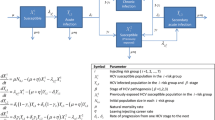Abstract
A number of behavioural and clinical parameters influence the transmission of an infectious agent through direct contact between two individuals. The behavioural parameters encountered in such situations are also likely to exhibit an enormous amount of variability. With the spread of hepatitis C among injecting drug users, the parameters associated with injecting behaviour play an important role in the modelling of the transmission process. Computer simulation modelling is an ideal approach to deal with a large number of parameters as well as high levels of variability without excessive simplification. The simulation model presented in this paper is tested on data from a cohort of injecting drug users and the results obtained are very encouraging from a public health perspective. The model clearly indicates that the rate at which HCV spreads through a population of injecting drug users is extremely sensitive to the interaction rate and to the probability of infection through a single contact with an infective. At the same time it shows that rate of spread is not very sensitive to initial prevalence, which is very encouraging from a public health perspective.
Similar content being viewed by others
References
Ackerman E, Elveback LR, Fox JP. The simulation of infectious diseases. Springfield: Charles C Thomas Publishers, 1984.
Kaplan EH. Needles that kill: Modeling human immunodeficiency virus transmission via shared drug injection equipment in shooting galeries. Rev Infectious diseases 1989; 11(2): 289–298.
Homer JB, St. Clair CL. A model of HIV transmission through needle sharing. Interfaces 1991; 21(3): 26–49.
Choo QL, Kuo G, Weiner AJ, Ovenby LR, Bradley DW, Houghton M. Isolation of a cDNA clone derived from blood-borne non-A, non-B viral hepatitis genome. Science 1989; 244: 359–363.
Alter HJ, Purcell RH, Shih JW, et al. Detection of antibody to hepatitis C virus in prospectively followed transfusion recipients with acute and chronic non-A non-B hepatitis. New England J Medicine 1989; 321: 1494–1500.
MacDonald M, Crofts N, Kaldor J. Transmission of hepatitis C virus: Rates, routes and co-factors. Epidemiology Rev 1996; 18: 137–148.
Alter HJ. To C or not to C: These are the questions. Blood 1995; 85: 1681–1695.
Patz JA, Jodrey D. Occupational health in surgery: Risks extend beyond the operating room. Aust N Z J Surg 1995; 65(9): 627–629.
Crofts N, Jolley D, Kaldor J, Van Beck I, Wodak A. The epidemiology of hepatitis C virus infection among injecting drug users in Australia. Journal of Epidemiology Community Health (In press).
Preston FE, Jarvis LM, Makris M, Philip L, Underwood JC, Ludlam CA, Simmonds P. Heterogeneity of HCV genotypes in haemophilia: Relationship with chronic liver disease. Blood 1995; 85: 1259–1262.
Takada N, Takase S, Takada A, Date T. Differences in the HCV genotypes in different countries. J Hepatology 1993; 17: 277–283.
Crofts N, Aitken CK. Incidence of bloodborne virus infection and risk behaviour in a cohort of injecting drug users in Victoria, 1990–1995. Medical J Australia 1997; 167: 17–20.
Blythe SP, Anderson RM. Variable infectiousness in HIV transmission models. IMA J Math Appl Med Biol 1988; 5: 181–200.
Author information
Authors and Affiliations
Rights and permissions
About this article
Cite this article
Mather, D., Crofts, N. A computer model of the spread of hepatitis C virus among injecting drug users. Eur J Epidemiol 15, 5–10 (1999). https://doi.org/10.1023/A:1007548307196
Issue Date:
DOI: https://doi.org/10.1023/A:1007548307196




